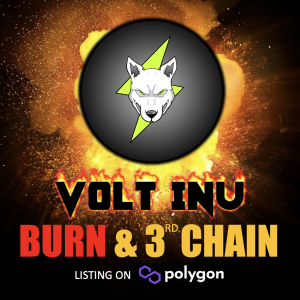Manhattan, New York Feb 10, 2023 (Issuewire.com) - Volt Inu, the DAO-powered deflationary meme coin is already making waves in the cryptocurrency community. And now, the project is poised to take things to the next level by reducing its bridge liquidity through the burning of 44.85 trillion VOLT tokens, while also launching on the rapidly growing Polygon blockchain network.
However, as one of the world’s leading decentralized autonomous organizations (DAO), the community will have the chance to have their voices heard and cast their vote on this groundbreaking development before it becomes implemented.
The innovative crypto project was initially launched on the Ethereum (ETH) blockchain network on December 19, 2021, with 100% of its supply allocated to Uniswap liquidity. Shortly after, in January 2022, VOLT was launched on a second blockchain (Binance Smart Chain, or "BSC") to gain more exposure and provide a solution to people who are unable or unwilling to pay the Ethereum blockchain's gas fees.
“This move seems appropriate as it will allow us to add a new option to hold VOLT in a decentralized way on a blockchain with low gas fees while targeting a new audience of users,” Volt Inu said in a statement.
The multi-utility meme token recorded tremendous success after its second deployment, with the BSC network having about twice as many holders as the ETH network. The Binance Smart Chain network currently has over 39,000 holders, while the ETH blockchain contains 19,000 address holders.
The token was subsequently listed on a number of exchanges, totaling over 100 CEXs and DEXs, including the top AMM DEX, MelegaSwap, which provides a staking program for Farms and Pools with a considerable APR.
As a result, for several months after the migration and multiple listings, the team received regular requests from the community to list VOLT on a third blockchain, with Polygon being the most frequently mentioned.
Therefore, the Volt Inu team submitted the over 44 trillion VOLT token’s burning and deployment on the Polygon blockchain for the community's confirmation. Additionally, they suggest taking 25% off the Uniswap liquidity and allocating it to the new blockchain in order to accomplish this and ensure smooth trading on the Polygon chain.
The team recognizes that the project's success is heavily reliant on community support and cooperation, which is why they use a mechanism known as the "single choice voting" system. This allows each person to cast a "single" vote to determine whether the plans will be brought to life or not. VOLT remains committed to promoting transparency and inclusiveness in its decision-making processes.
Now, Volt Inu is offering two different options for the community to select from. The first option is to burn the current bridge liquidity and list VOLT on the Polygon network; while the second option is to maintain the status quo and continue without deploying the Polygon network.
The current "single-choice voting" process, which started on February 5 and will end on February 12, is aimed at determining the future of the VOLT token and its deployment on the Polygon network. Similarly, it seeks to reduce the bridge liquidity by burning 44,850,000,000,000 VOLT (currently worth about $56M) out of circulation.
This multi-million dollar burning decision was made in light of the hacks that cross-chain bridges have experienced in recent months. As such, this will reduce the impact of such attacks (if they eventually happen) by reducing the number of tokens locked in the bridge contract.
If the community decides to proceed with the first option, the proposal submitted to the DAO will be validated, leading to a new 24-hour poll being submitted on EverOwn. This poll will validate and execute the withdrawal of 25% of the token's liquidity, which is required for Volt Inu (VOLT) to be listed on the Polygon network.
The token will continue to function as it does on the two current blockchain networks (BSC and ETH) if the community chooses to repudiate the first options and the proposal eventually becomes unsuccessful.
However, it appears that the vote is already on track for success, even though attempting to deploy a token on another smart contract on another blockchain network may pose its own risks if proper precautions are not taken.
At the time of publication, the first option had 11 trillion VOLT tokens, representing a staggering percentage of 99.97%. The second option, on the other hand, only has 2.9 billion tokens allocated to it. This only accounts for 0.03% overall.
Check out the following pages to find out more information about Volt Inu and join the thriving VOLT ARMY community:
Media Contact
MelegaSwap *****@melegaswap.finance http://melegaswap.finance









